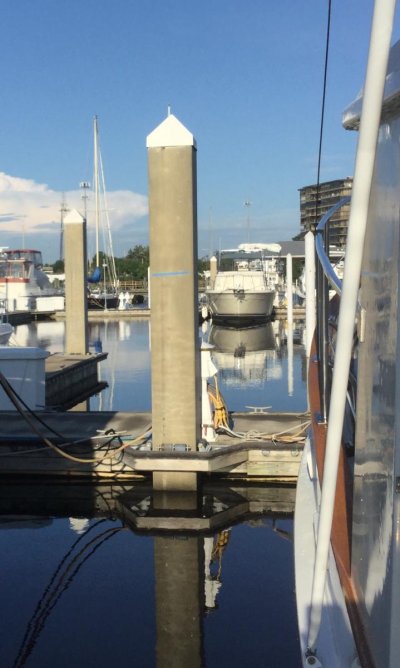hmason
Guru
- Joined
- Aug 9, 2013
- Messages
- 2,828
- Location
- USA
- Vessel Name
- Lucky Lucky
- Vessel Make
- Pacific Mariner 65
I'm asking a question that has so many variables that a definitive answer is likely impossible. I would however like the thinking of the group.
We are spending our first hurricane season as liveaboards in Florida. Should there be a hurricane targeting us we have no intention of staying aboard however we would like to protect the boat as well as possible. I've already decided not to haul the boat. I have seen scenarios where hauled boats have sustained significant damage while boats in the water did better. I've made that decision so let's not debate that.
The marina we are at was destroyed by a hurricane (Irene?) a number of years ago and has been rebuilt to very strong standards. We are at a floating dock anchored by steel pilings. All the floating docks are behind a seawall. The dock system is designed so that extra cleats are easily added at virtually any position to accommodate storm lines. The location is 5-miles up the St. Lucie River which is part of the Okeechobee Waterway. Storm surge is certainly possible but the likelihood of the docks riding over the pilings is quite small.
The marina also has a mooring field. The moorings are of helix design and are inspected annually. Although there are some boats in the mooring field during the summer season it is by no means crowded or near capacity. I have read that helix moorings when properly installed and inspected are extremely rugged.
OK, here's the question TF'ers: Which do you think would be the safest--dock or mooring?
Thanks, Howard
We are spending our first hurricane season as liveaboards in Florida. Should there be a hurricane targeting us we have no intention of staying aboard however we would like to protect the boat as well as possible. I've already decided not to haul the boat. I have seen scenarios where hauled boats have sustained significant damage while boats in the water did better. I've made that decision so let's not debate that.
The marina we are at was destroyed by a hurricane (Irene?) a number of years ago and has been rebuilt to very strong standards. We are at a floating dock anchored by steel pilings. All the floating docks are behind a seawall. The dock system is designed so that extra cleats are easily added at virtually any position to accommodate storm lines. The location is 5-miles up the St. Lucie River which is part of the Okeechobee Waterway. Storm surge is certainly possible but the likelihood of the docks riding over the pilings is quite small.
The marina also has a mooring field. The moorings are of helix design and are inspected annually. Although there are some boats in the mooring field during the summer season it is by no means crowded or near capacity. I have read that helix moorings when properly installed and inspected are extremely rugged.
OK, here's the question TF'ers: Which do you think would be the safest--dock or mooring?
Thanks, Howard

